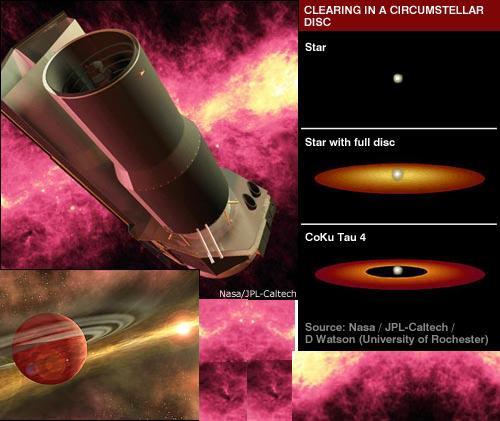Avi Blizovsky

In the bottom photo: a demonstration showing what the Coco Tau 4 system might look like. Above it: the Spitzer telescope and on the right - an explanation of the discovery process
Direct link to this page: https://www.hayadan.org.il/spitzer310504.html
The Spitzer Space Telescope found evidence of a planet orbiting a distant star less than a million years old. The infrared space observatory studied five stars in the Taurus group, located 420 light years from Earth.
All the stars were surrounded by dust disks, where planets are supposed to form from the material in their surroundings. Near the fourth of the nearby stars, CoKu Tau 4, Spitzer saw a region free of dust as it was sucked into the new world.
NASA is excited about the latest discovery made by the telescope that cost 2 billion dollars and was launched in August. The telescope can't see the size of the planet directly, but its infrared detectors can penetrate the clouds of dust around young stars, where planets form.
Spitzer discovered significant amounts of organic matter and ice scattered in droplets throughout the planet-building region. These materials - frozen droplets of particles covered in water, methanol and carbon dioxide may explain the origin of icy bodies such as comets, say NASA.
Scientists believe that such comets filled the primitive Earth with water and other chemicals that became the building blocks of life.
Spitzer's preliminary findings show that the new telescope dramatically expands our understanding of how stars and planets form." said Dr. Michael Warner (Werner), chief scientist on the Spitzer Project at NASA's Jet Propulsion Laboratory in California.
Comparison with the Earth
Spitzer's findings of a clean path in the Cocco-Tau 4 disc - like a vacuum cleaner leaving a clean trail on a dirty carpet, as NASA describes it, are of enormous importance.
Spitzer is able to reveal more about the structure of such gaps in the disks around young stars, as could not be done until now.
Since the Koko Tau 4 system is barely a million years old, the possible planet must be younger. This is compared to the earth whose age is now estimated to be 4.5 billion years. The planet of Koko Tau 4 must therefore be in the very early stages of its formation process and this will help astronomers understand how planets like ours formed.
Spitzer also discovered two of the faintest and most distant planet-forming disks ever discovered. They orbit two of over 300 newly formed stars in a star hothouse called RCW 49, 13,700 light-years away.
Astronomers believe that the formation of dust disks around stars is a common phenomenon that indicates that planets, formed from these disks, are common throughout the universe. "By looking at what lies behind the dust, Spitzer has shown us that star and planet formation are very active processes in our galaxy," said Dr. Ed Churchwell (Churchwell) of the University of Wisconsin.
For news at the BBC
Know planets outside the solar system
https://www.hayadan.org.il/BuildaGate4/general2/data_card.php?Cat=~~~855689576~~~70&SiteName=hayadan
